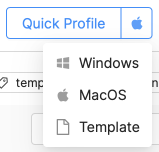Creating and launching a profile
A profile is a generated set of fingerprints collected from real devices that is seen as a unique device by services. A profile stores information about the browser settings that have been set, and launches the browser.
Creating a profile

There are two ways to create a browser profile: Quick Profile and Create Profile.
A quick profile is a one-click profile created using a randomized browser profile fingerprint and a random name. Before creating a quick profile, you can click on the operating system icon and select the required one (you can choose Windows, macOS Intel, macOS ARM, and Android). By default, the operating system of a quick profile will be the same as the operating system of the device on which Octo Browser is launched. For example, if you are running Windows 11 on your device, when you create a Windows-based Quick Profile, its OS version will be Windows 11.
If you create a profile with a different operating system:
- If you create a macOS profile on a Windows-based device, it will be created with the random macOS version of the type you selected (Intel or ARM).
- If you run a macOS system and create a Windows profile, its OS version will be Windows of a random version (Windows 10 or 11).
You can use a device running any operating system to create a profile with a mobile fingerprint.
It is also possible to create a quick profile using a template, provided that a template has been previously activated in the Templates tab. To do this, click on the template icon in the same drop-down list. Such profiles can be useful if you need to quickly launch a profile with random parameters. By default the connection will be direct (without a proxy). If you use, e.g., a VPN after creating and launching such a profile, the external IP address will be the VPN address.

Create Profile allows you to create a profile while fine-tuning its settings manually. You can read more about setting up a new profile here.
By default, the OS of the newly created profile will be identical to the OS of the device on which Octo Browser is installed. If necessary, you can change this setting when you create a new profile. You cannot change the OS in an already created and saved profile.
Launching a profile
After a profile has been created, it will appear on the list (the general table containing all profiles). To launch a profile, select the one you need and click the Start button.

When a profile starts, your connection will be checked and the chosen settings for the profile will be applied.
On the Team and Advanced subscriptions, other Octo Browser accounts (i.e., team members) can use common profiles of the master account. To do this, you need to invite team members and assign them access rights; one profile can only be launched by one team member at a time.
For subscription tiers without teamwork options you can use only one account, but with an unlimited number of devices. However, one profile can be run on one device only at a time.
You can read more about profile settings here.
Synchronization
Synchronization of profile data is automatic. To send the latest profile version to the cloud storage, simply exit the profile, close the window, or click the Stop button in the Client app. Wait for the synchronization to finish. When you launch this profile from any device, the latest (up-to-date) version of the profile will be run.
If you have logged out of the Octo Browser account while the profile window remains open, the profile will be saved when you close the window or when you log back into your account and click the Stop button.
If you have lost Internet connection and closed the Octo Browser Client or turned off your device, your profile will remain in the active (launched) state until the device is back online and you restart the Client app. When your device is back online and you restart the Client app, the latest launched version of the profile (which is stored locally) will be synchronized, and the profile status will change to inactive.
For synchronization to work correctly, close all profiles and wait for synchronization to finish before shutting down your device. If your device has gone to sleep and a profile has not been closed, this profile will appear as running when you open the Client app on another device and/or for the other team members.
If a profile has not been closed on one device, but you need to use this profile on another device, you can force stop a profile to close it. In this case the profile status on the server will change forcibly, and you will be able to load the previous profile version (the version of the last successful synchronization), while the profile version on the device on which the profile was not closed normally will not be synchronized.
In other words, the data that you have from websites and services on the device on which the profile remained in a running state with an active status will be replaced with data from the previous version of the profile.
Perform this procedure at your own risk. Some services can notice and negatively assess such manipulations.